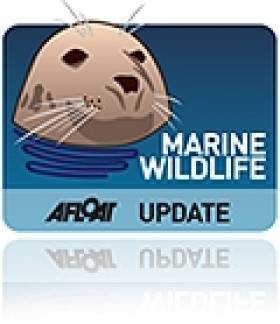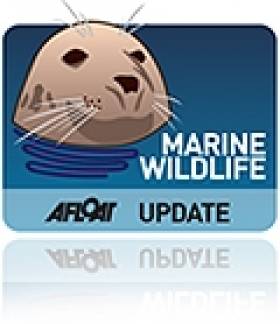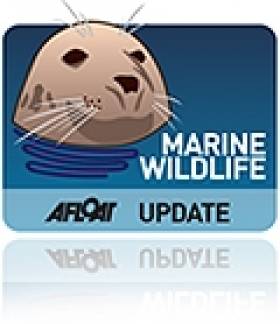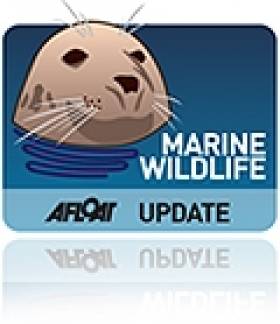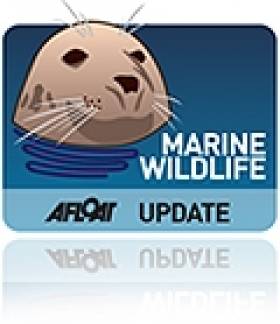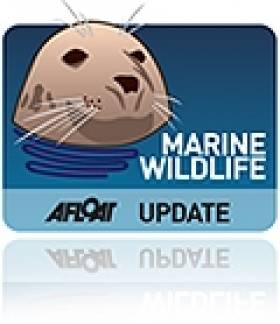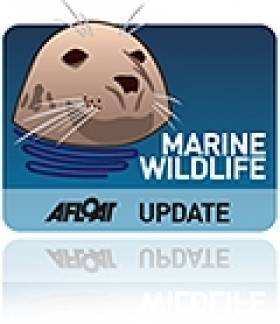Displaying items by tag: marine wildlife
Preliminary Results On Stranded Killer Whale
#MarineWildlife - Preliminary results from the post-mortem on the female killer whale that stranded in Waterford last week show no obvious cause of death.
As previously reported on Afloat.ie, the five-metre-long female orca was discovered near Tramore last Friday (30 January) amid an unusually high number of cetacean strandings in the first month of this year.
While it was suggested that the killer whale's worn teeth might point to malnutrition, Dr Simon Berrow of the Irish Whale and Dolphin Group (IWDG) explains that such teeth are typical of 'type 1' orcas in the North Atlantic.
The 'type 1' ecotype feed mostly on fish, and are smaller than their 'type 2' marine mammal-eating counterparts.
According to Dr Berrow, samples of skin have been taken for analysis, and tissue from the blubber, liver, kidney and muscles will be studied in greater detail for potential contaminants that could lead to various conditions such as infertility.
"As biologists we can only explore the life of this whale and not determine the cause of death," he says.
"Obviously if there was something obvious or a severe infection, etc, we would recognise this but often an animal may have a number of 'conditions' which are not fatal, and determining cause of death is based on the most likely fatal condition.
"Unfortunately Ireland does not have a post-mortem system for marine mammals, unlike most European countries, so the factors leading to mortality of stranded animals is not known," he adds.
The IWDG has more on the story HERE.
Inflatable Whales Pop up at Portsmouth International Port for Marine Wildlife Festival
#portsmouthwhales – It's not often children get the chance to put their head in the mouth of a shark, but that's just one exciting adventure they can have at Portsmouth International Port's Marine Wildlife Festival in February.
It won't be a real shark, of course, but one of 13 life sized inflatable models of whales, sharks and dolphins that will be on display in the terminal building. The biggest is 42–feet long, that's 13 metres of whale that you can stand next to. Four will be hanging from the ceiling.
The 'pop up' exhibition opens on the 11th February, with classes from schools all around Portsmouth already booked to come and take part in a "Whale Workshop". Experts from marine wildlife charity ORCA will be taking lessons, with students learning all about the whales, dolphins, porpoises, sharks, seals and turtles that can be found on a Ferry crossing from Portsmouth International Port. Passengers and locals can also come and visit at any time during the four day long exhibition.
Whale watching is becoming a popular holiday pastime, with people paying thousands for trips around the world. Yet few realise they can see a huge variety of whales and other species when sailing from Portsmouth to Spain as part of a holiday or other trip. This is because the ferries travel through the Bay of Biscay, which is a whale and dolphin hotspot thanks to the variety of depth ranging from 200 – 4,999 metres deep and the abundance of food that suits many different species. This includes the deep diving Sperm Whale and Cuvier's Beaked Whale, making it a perfect spot for passengers to go looking for these magnificent creatures.
Martin Putman, Port Manager of Portsmouth International Port, said 'Since Brittany Ferries launched its whale watching mini cruises a few years ago we've become known as a gateway port for seeing whales, dolphins and other beautiful marine mammals. Anyone heading off on holiday to Spain has the chance of a memorable encounter, and this incredible Marine Wildlife Festival gives a great idea of what you might see."
ORCA has been working hard with Brittany Ferries for 10 years, with wildlife officers onboard the 'Pont Aven' and 'Cap Finistère' recording sightings of Marine wildlife. The charity is always keen to share its knowledge with passengers, helping them to understand more about what is in the sea around them.
Anna Bunney ORCA Community Wildlife Officer said, "People don't fully appreciate how accessible a wide variety of species is right on our doorstep. There's no need to spend big money to see whales when it's often an added bonus when travelling from Portsmouth International Port. We're delighted to be a part of the Marine Wildlife Festival, bringing this rich variety of creatures to life inside the terminal building."
On display will be life-size models of a 13m long female Sperm Whale, 8m Minke Whale, 8m Basking Shark, 6m Pilot Whale, 6m Orca Whale, 3m Orca Whale Calf, 3m, Risso's Dolphin, 3m Bottlenose Dolphin, 2m Common Dolphin, 2m Striped Dolphin, 1.5m Harbour Porpoise, 2m Grey Seal male, female & calf, and a 2m Leatherback Turtle.
There will be one more loveable whale also in attendance. Pip, Portsmouth International Port's cuddly human sized mascot, will be making an appearance for photos with young children and families off on half term holidays.
Shark Takes A Bite Out Of Scottish Killer Whale
#MarineWildlife - A conspicuous chunk missing from the tail fluke of a killer whale resident in Scottish waters is evidence of an altercation with a shark, as BBC News reports.
The orca, known as John Doe, is one of the familiar pod of killer whales that's commonly seen off the west of Scotland but has also been spotted in Donegal and off the east Scottish coast near Aberdeen.
Marine scientists have long been interested in the group because of its genetic distinctness from other killer whales in the north Atlantic – with studies showing they bear closer relation to orcas found in Antarctic waters.
And this latest discovery is troubling in light of the group's already precarious status, with no calves recorded among them since experts began to study them two decades ago.
The Hebridean Whale and Dolphin Trust (HWDT) said it could not "realistically speculate" on what species of shark may have been to blame for the bite.
But one it most certainly isn't is the plankton-hungry basking shark, a species that's seen a drastic fall in numbers locally over the past year, according to the Irish Examiner.
Sightings of the ocean's second largest fish – after the similarly harmless whale shark – have dwindled by a third on 2013 figures, which the HWDT says is part of a trend.
However, experts have moved to quell any concerns over the health of the marine species, as they may simply have moved to offshore waters – or below the surface – in search of greater supplies of their favourite foodstuff.
Basking sharks may be seen less often, but there's another shark species in the oceans that even the experts know very little about – and one of them was just landed in the Philippines.
The Washington Post has more on the 'mysterious' megamouth shark, a prehistoric looking beast that was only discovered by science in 1976 and has been sighted just 64 times since then.
Scientists still have no idea of the size of their population or in what oceans they're concentrated, and this find may reveal little more - but it might tell us something new about their plankton-based diet and their unique physiology.
London Natural History Museum's New Blue Whale Display Has Irish Origins
#MarineWildlife - News emerged this week that Dippy, the famous diplodocus cast at the entrance of London's Natural History Museum, is to be replaced with the skeleton of a blue whale.
But amid all the hubbub that this move has sparked, perhaps little known is the replacement creature's Irish origin.
According to Geographical, the magazine of the Royal Geographic Society, the museum's blue whale skeleton is from a female whale that was beached off Wexford more than 100 years ago.
The giant marine mammal was reportedly already injured when it washed up at Wexford Harbour in 1891, says whaling expert Phillip Hoare, who notes that the museum paid £250 (some £27,000 in today's money) for the carcass – which produced an incredible 630 gallons of valuable whale oil.
That rendering was done at the museum itself, which had a 'whale pit' reserved for such purposes till the 1940s, when complaints from the neighbours about the smell put paid to that practice.
What's more, the Wexford whale that will have pride of place in the museum's atrium is just one of countless other specimens acquired over the decades, many of which are stores in a warehouse in south London.
Geographical has more on the story HERE.
Killer Whale Strands On Waterford Beach
#MarineWildlife - The Irish Whale and Dolphin Group (IWDG) reports on a killer whale stranding near Tramore in Co Waterford yesterday (Friday 30 January).
The five-metre-long female orca was described as being in "a very fresh condition" and was found to have very worn teeth, which points to malnutrition as a potential cause of death.
A post-mortem is scheduled to be carried out tomorrow by a team from the IWDG and Galway-Mayo IT.
The incident is the latest in a "disturbing high" rate of cetacean strandings around the Irish coast this January, with a total of 32 recorded across nine identifiable species.
While it's as yet unknown what has caused this spike in numbers, the recent severe weather systems coming from the Atlantic may be a factor in driving carcasses of animals that may have died of natural causes towards the Irish coast.
The IWDG has more on the story HERE.
#MarineWildlife - Columba, the young loggerhead turtle rescued from near freezing waters on the Donegal coast last week, has died.
As the Belfast Telegraph reports, staff at the Exploris aquarium in Portaferry fought hard to save the junior turtle's life after it was discovered hundreds of miles from the warmer waters of the Gulf Stream, but it sadly passed away on Monday night (26 January).
A post-mortem was scheduled to determine whether illness may have caused the 12-year-old reptile to veer so far off course into Ireland's dangerously cold winter waters.
But for every sad story, the marine wildlife rehab staff at Exploris have many more happy tales to tell.
Since 1989, the Co Down aquarium has rescued 187 common seals, 253 grey seals and 10 loggerheads, with the vast majority returned to the wild in full health.
And they've come to the sanctuary from all over Ireland, with 1990 in particular being a big year for rescues of loggerhead turtles at Achill Island, Galway Bay and Brandon Bay, the aquarium's first.
There are some unusual rescue animals, too, such as a white lobster found in Carnlough in Co Antrim four years ago. The Belfast Telegraph has much more HERE.
Secrets Of Ireland's Humpback Whales Revealed
#MarineWildlife - The mystery of where Ireland's humpback whales to go give birth remains – but two whales have been tracked between the Irish coast and feeding grounds in the Arctic for the first time.
That's the big news from a new research paper in the Journal of the Marine Biological Association of the United Kingdom, a collaborative effort between the Irish Whale and Dolphin Group (IWDG) and marine science colleagues in the United States, Iceland, Norway and the Netherlands.
According to co-author Dr Conor Ryan, the study reports on a comparison of the 28 humpback whales that have been photo IDed in Irish waters with a catalogue of over 8,000 such whales throughout the North Atlantic.
Ireland's "main stomping ground for humpbacks" was also examined in the paper, with a strong seasonal trend showing the whales appearing off the Kerry coast each summer – as tourists on the Wild Atlantic Way are becoming well aware.
IrishCentral reports on the latest BBC film shoot to capture the majestic marine mammals in their natural environment, before they move on to West Cork in autumn and further east to Waterford and Wexford as winter progresses – matching the movements of spawning sprat and herring shoals.
The IWDG website has much more on the story HERE.
Lookout Urged For Beaches Turtles After Rare Species Find
#MarineWildlife - Seaside visitors are being asked to look out for turtles washed up on the shore after a rare example of the world's smallest sea turtle was discovered in Donegal over Christmas.
According to the Irish Independent, the body of the foot-long Kemp's ridley turtle – declared by National Geographic to be the most endangered sea turtle species on earth – was found on the rocks at popular surfing spot Rossnowlagh beach on Christmas Day.
It turned out to be one of four such turtles discovered in the British Isles in just the last few weeks – far from their usual, much warmer climes in the Gulf of Mexico.
And they're not the only marine wildlife to look out for, as photographer David Comerford tells TheJournal.ie about a stranded seal pup he found at the Sutton end of Bull Island last night.
The little seal "appeared to be in good health" though it has "a clear injury to one of its flippers". The Irish Seal Sanctuary has been notified and is co-ordinating a response with local vets.
Update: The Irish Times has video of the seal pup returning to the sea as the tide came in.
Scottish Scientists At A Loss To Explain Beaked Whale Strandings
#MarineWildlife - An "unusually large number" of Cuvier’s beaked whale strandings in western Scotland in recent weeks has baffled marine scientists, as The Scotsman reports.
Five of the rarely seen species were found washed up on Scotland's west coast in late December, a five-fold rise on the annual average.
And as Dr Conor Ryan of the Hebridean Whale and Dolphin Trust states, there are "no obvious clues as to what is causing such an obvious increase in strandings."
Recent stormy conditions may be a factor, he said, but alone they don't explain "why we are finding just one deep-diving species in such high numbers."
According to BBC Earth, Cuvier's beaked whales are the deepest diving of any large marine wildlife, plunging almost 3km into the depths in search of food, thanks to a unique physiology that allows them to withstand the crushing pressures and lack of oxygen.
It's possible that the whales may have succumbed to 'the bends' – which killed 14 beaked whales that washed up in the Canaries in 2002 – but the poor condition of the carcasses has ruled out any clues that a postmortem might provide.
The Scotsman has more on the story HERE.
#MarineWildlife - As protections on endangered whale species help buoy their numbers in the world's oceans, the chances of a blue-water encounter – while still slim – are getting better every year.
But at the same time grows the fear of a collision with one of these ocean giants that looms at the back of every offshore sailor's mind.
However, as Yachting World reports, there may be measures you can take to minimise that risk should you come in close quarters with a whale – or better yet, a whale pod.
Does painting the bottom of your boat in the colour red help? It turns out that it might make all the difference, as some scientific research suggests whales can perceive that colour in stark contrast to the rest of their environment, giving them a chance to swim around the vessel and keep danger at bay.
Speed is also an issue, with the vast majority of whale collisions occurring at speeds of over 14 knots – a trend that could be curbed by managing speed limits in whale-rich zones, plotting smarter courses or using dedicated on-deck observers.
Still the vast majority of encounters with whales are peaceful, even "dumbfounding" – but you don't want to startle them, as one group of divers off the island of Dominica learned when a sperm whale released its bowels right on top of them.
The Irish Mirror reports that the "poo cloud" is thought to be a defence mechanism – clouding the clear Caribbean water with a "poonado", as diver and photographer Keri Wilk described the 30-metre wide mass of waste.
"I had poop in my eyes, mouth, wetsuit, everywhere and I was soaked in it from head to toe," he said – though luckily it washed away quickly, bad smells and all!


























